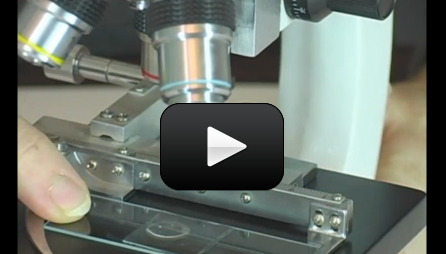Make sure you’ve completed the How to Use a Microscope and also the Wet Mount activities before you start here!
If your critter is hard to see, you can use a dye to bring out the cell structure and make it easier to view. There are lots of different types of stains, depending on what you’re looking at.
The procedure is simple, although kids will probably stain not only their specimens, but the table and their fingers, too. Protect your surfaces with a plastic tablecloth and use gloves if you want to.
We’re going to use an iodine stain, which is used in chemistry as an indicator (it turns dark blue) for starch. This makes iodine a good choice when looking at plants. You can also use Lugol’s Stain, which also reacts with starch and will turn your specimen black to make the cell nuclei visible. Methylene blue is a good choice for looking at animal cells, blood, and tissues.
In addition to your specimen, you’ll need to get out your slides, microscope, cover slips, eye dropper, tweezers, iodine (you can use regular, non-clear iodine from the drug store), and a scrap of onion. If you can find an elodea leaf, add it to your pile (check with your local garden store). Here’s what you do:
[am4show have=’p8;p9;p11;p38;p92;p26;p53;p74;p86;p87;’ guest_error=’Guest error message’ user_error=’User error message’ ]
Download Student Worksheet & Exercises
1. Fill a container with water and add a small piece of elodea leaf and onion. You’ll want the onion to be a thin slice, no more than a quarter of an inch thick.
2. Practice making a wet mount first. Put a fresh slide on the table. Using tweezers, pull off a thin layer of onion (use a layer from the middle, not the top) and place it on your slide. Gently stretch out the wrinkles (use a toothpick or tweezers) and add a small drop of water and cover with a cover slip. Take a peek at what your specimen looks like on low power – do you notice it’s hard to see much? Draw what you see in your notebook.
3. Now increase the power and look again. Draw a new sketch in your notebook.
4. Now we’re going to highlight the cell structure using iodine. Lugol’s is also iodine, but the regular brown stuff from the drug store works, too. Grab a bottle of the one you’re going to use.
5. To stain the specimen, we’re going to add the stain to one side of the cover slip and wick away the water from the other side. Use a folded piece of tissue paper and touch it lightly to one side of the cover slip as you add a single drop of stain to the other side. When the stain has flowed through the entire specimen, take a peek and draw what you see in a a fresh circle.
6. Do the same thing with the elodea leaf. And anything else plant-based from your backyard. Or refrigerator. Draw what you see and don’t forget to label it with a title and power of magnification!
Exercises
- Why do we use a wet mount slide?
- Give one example of a specimen that would use a wet mount slide?
- How do you prepare a wet mount slide?
- Why do we stain specimens?
- Give one example of a specimen that would use a stain.
- What type of stain can we use (give at least one example).
[/am4show]


We don’t have the program available by grade, so we ask that you request us to unlock an entire grade for you. Can you send us an email? aurora@superchargedscience.com and let us know which level you’d like!
Staining is listed for 3rd grade, but we don’t have access to the video, is this correct?
I went to the beach and I saw a jellyfish